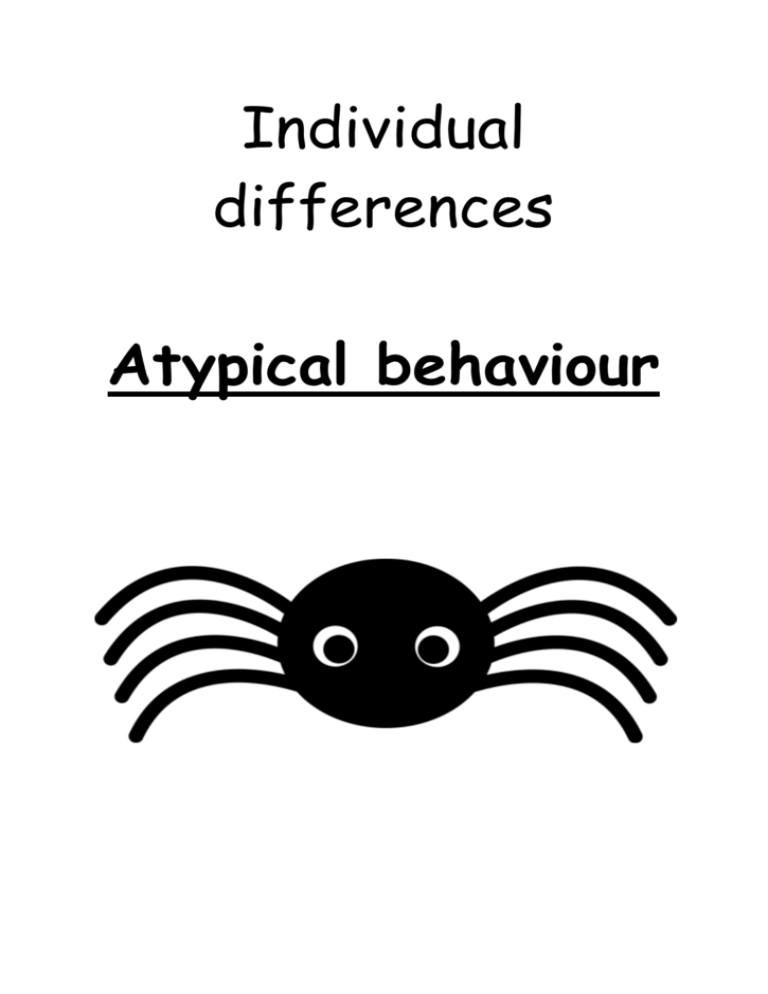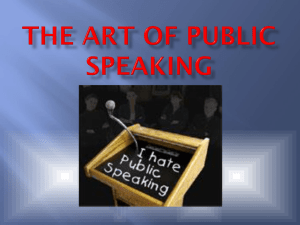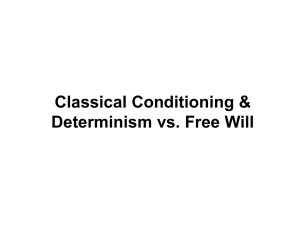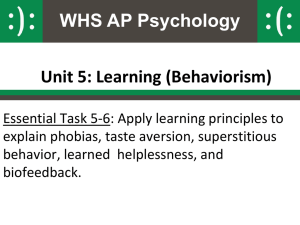Phobias - Accrington Academy
advertisement

Individual differences Atypical behaviour Unit one: Atypical behaviour Key concepts Candidates should be able to: • distinguish between typical and atypical behaviour in relation to fear; • outline common types of phobia: agoraphobia, social phobia, school phobia, acrophobia and arachnophobia. Core theory: behaviourist theory Candidates should be able to: • distinguish between an unconditioned stimulus, neutral stimulus and a conditioned stimulus; • distinguish between an unconditioned response and a conditioned response; • use the process of classical conditioning to explain the onset of phobias; • explain the criticisms of the behaviourist theory of atypical behaviour; Alternative theory: Evolutionary theory Candidates should be able to: • consider evolutionary theory as an alternative theory, with specific reference to preparedness. Core study: Watson and Rayner (1920) Candidates should be able to: • describe Watson and Rayner’s experiment to induce a phobia in a young child; • outline limitations of Watson and Rayner’s study. Application of research into atypical behaviour: behaviour therapy for phobias Candidates should be able to: • explain how research relates to psychological behaviour therapy for phobias, e.g. use of stimuli in systematic desensitisation, use of classical conditioning in flooding and implosion therapy, cognitive therapy Key terms Typical behaviour Behaviour that is considered normal and normally applies to the majority Atypical behaviour Behaviour that is considered to be abnormal , usually this applies to the minority A strong response of fear which is abnormal considering the stimulus (e.g. its considered normal for us to fear death, but not normal if you respond in the same way to a spider as you would to a gun being pointed at you) Fear of being in a public place or situation where you feel you would not be able to escape. Fear of social situations and of embarrassing yourself and worrying what others might think of you Phobia Agoraphobia Social phobia School phobia Acrophobia Fear of attending or being in school, linked to fearing not being at home and fearing that you will embarrass yourself whilst at school Fear of heights (think of acrobats to help you remember it) Arachnophobia Fear of spiders Core theory: Behaviourist theory The behaviourist theory suggests that we learn phobias. According to this theory, there are two ways in which this could happen. These are classical conditioning and operant conditioning. Classical conditioning This is when people form an association between two things. In classical conditioning it is suggested that there are stimuli which we already have responses for, these are called unconditioned (as in not learnt). An unconditioned stimulus (e.g. pain) leads to an unconditioned response (e.g. fear). If the unconditioned stimulus is paired with a neutral stimulus (e.g. we learn to associate the pain of being stung with a bee), then we eventually will give the same response when we encounter the neutral stimulus as we did when we encountered the unconditioned stimulus (e.g. we give the response of fear when we see a bee as we have learnt to associate it with pain which we already have the response of fear). This is because the neutral stimulus has now become the conditioned stimulus as we have learnt to respond to it in a certain way. Use the equation if it helps you. Stimulus generalisation occurs when we generalise the conditioned stimulus to include anything that is similar e.g. I might generalise bees to include flies. Extinction occurs if we encounter the conditioned stimulus a number of times without the unconditioned stimulus occurring e.g. I come across bees on numerous occasions and am not stung so feel no pain. I eventually stop associating bees with being stung and stop showing my response to them. Operant conditioning This type of learning suggests that we learn through the consequences of our actions. If our behaviour is rewarded then we will repeat it, if there are negative consequences we won’t. Positive reinforcement is when our behaviour is rewarded. E.g. if a child is afraid of the dark, their mum might give them lots of cuddles when it’s dark. The child might show their fear in the future to get the extra cuddles from mum. Negative reinforcement is when our behaviour is rewarded by something we don’t like stopping. E.g. if a child is experiencing something unpleasant at school (bullying) then they might stay away from school so they don’t encounter it, this could result in school phobia and them never wanting to go to school. Punishments can stop us behaving in a certain way. E.g. someone might lack confidence when with other people and might feel embarrassed or anxious. Going to parties and being around lots of people would be like a punishment to them, so they would stop going and might develop social phobia. Criticisms There are a number of limitations with the behaviourist theory This theory ignores that fact that we think about our behaviours. For example, two people may have been attacked on a dark night. One person may develop a fear of the dark and think irrationally that if they go out in the dark again, the same thing will happen. Whilst the other person may think rationally and believe that they were just in the wrong place at the wrong time and that they will probably be fine next time. This shows that we do think about our actions and do not just learn associations or through rewards and consequences without thinking about the process. Another limitation is that this theory suggests you learn through having a direct experience with the stimulus. However, some people learn through social learning. For example, a child might learn to be afraid of spiders because their mum has always screamed and shown fear towards them. The child might never have had a negative experience with a spider, but would still show a fear of them. Lastly this theory is unable to explain why some people have phobias of things that they have never been in contact with. For example, a person may have a fear of snakes, however, it is likely that they have never had an experience with a dangerous snake (the fear often being that it could hurt you) other than at the zoo when it is safely behind glass. Some people may just be born with certain fears. Alternative theory: Evolutionary theory This theory suggests that we may be born with a predisposition to develop some phobias. This is because we have developed in order to be able to survive and reproduce; the suggestion is that by fearing certain things, we increase our chance of successfully reproducing and surviving. There are certain things which are potentially threatening to our survival. The dark –we cannot see predators coming or see well enough to avoid obstacles which may cause injury and/or death. Heights –experience shows us that people who fall are likely to die, the higher they fall from, the more sever the injury is likely to be, we don’t want to get injured and die! Flying –we are not designed to fly, if we are in the air, the chances are we will fall (and die). Closed spaces –we need to be able to eat and breathe, if the space is enclosed, we may run out of air and die. If we get stuck, we would be unable to go and find food and water, we would also be unable to escape if a predator found us. All resulting in us dying! Animals –this theory suggests we should fear things that are unlike us as we do not know how they are going to move or respond to things. Animals without limbs –confuse us as they don’t move in the same ways as us e.g. snakes. Animals with lots of limbs –very different from us, why do they need so many? What are they going to do with them all? E.g. spiders. Flying animals –we cannot fly as previously stated, we don’t understand how they can or why they need to e.g. birds. Evidence suggests that it is more difficult to treat many of these phobias, suggesting that they are somehow ‘deeper’ than other phobias. This backs up the idea that we have some kind of preparedness to fear these things. Core study: Watson and Rayner (1920) Aim To investigate whether a phobia could be learnt using the principles of classical conditioning. Procedure ‘Little Albert’ grew up in a hospital environment (his mum worked in a hospital), when he was 9 months old, he was tested to see if he was afraid of anything. They found that Albert did not show fear to any of the stimuli except to the noise of a metal bar being hit with a hammer, it was found that this made him cry. When he was 11 months old, they brought him back and began the experiment. They used the unconditioned stimulus they had found Albert was afraid of (noise of metal bar being hit with a hammer) and paired it with a white rat (neutral stimulus) which Albert had been shown before and gave no real response to. After numerous trials, Albert began to associate the bang of a hammer hitting a metal bar (UCS) with the white rat (NS). When he saw the white rat, he cried. Results Watson and Rayner had successfully taught Albert to be afraid of a white rat. It was also found that Albert generalised the stimulus and showed his conditioned response for other things which were similar to the white rat. He cried when he was presented with a rabbit, a father Christmas mask (the white beard made him cry) and a real fur coat amongst other things. One month after the experiment, Albert still showed a (decreased) fear of the white rat. His mum then decided that she didn’t want him being tested on any more so Watson and Rayner were unable to see if they could remove the phobia. Conclusion Phobias can be learnt using classical conditioning. Criticisms/Limitations Poor Little Albert! This study was highly unethical, Albert was distressed during the process (cried a lot!) and he ended up with a phobia of an animal that hadn’t bothered him before the experiment. They didn’t attempt to uncondition the phobia, so Albert may have been afraid of these things for the rest of his life. There is also some suggestion that his mum did not fully understand what was going to be done when she allowed him to take part in the experiment. This experiment lacks ecological validity, it was all done in artificial environment which was unlike anything that would naturally happen in real life. This was only conducted on one child. We cannot say if other children would respond in the same way as Albert, or if it would even work on adults at all. It may be that if another neutral stimulus was used, Albert might not have shown a phobia (e.g. if they had used a duck). Applications of research: Treating phobias The reason psychologists are so interested in how we develop phobias, is that they want to find out how to treat them. Many people have phobias which impact on their day to day lives, if we had an easy cure, many of those people would be very grateful for it. Behaviour therapy suggests that if a phobia is learnt, then we should be able to unlearn it by reversing the process. The following are all types of behaviour therapy. Flooding This is when a patient is ‘flooded’ with their fear. They are put in a fearful situation and left there until they calm down. The theory is that we are unable to stay in a high state of arousal (fear) for a long period of time, so sooner or later, the patient will have to calm down. When this happens, they will realise that they are feeling calm in a fearful situation and a new association will be formed between being in the fearful situation and feeling calm. For example, if you have a fear of heights, you would be taken to a high bridge and have to stand there until you are calm. Implosion therapy This is the same as flooding, except instead of being put in the fearful situation, the patient has to imagine themselves in it. These makes the therapy more ethical as the individual is not subjected to their fear, but just has to imagine themselves in the situation. For example, imagining you are on the bridge and trying to remain calm. Systematic desensitisation For this treatment, the patient is taken through a number of steps. First, they are taught a relaxation technique which often involves breathing exercises. Once they have mastered this, they create an anxiety hierarchy with their therapist. This is basically a list of situations involving their phobia. At the start of the list would be something that they don’t find too fearful and this would build up to the worst possible situation at the end of the list. For example, the start of the list for a fear of heights may be standing on a step stool, it may then move on to standing on the 4th step of a ladder. Then move up to being at the top of the ladder and so on until you list the worst possible situation e.g. being alone on a high bridge. The therapist then takes them through each situation, making them use the breathing technique at each one to make themselves calm. The idea being that they form a new association between being calm and being in the situation. When the patient can cope with the first situation on the list, the therapist then moves them on to the next one and so on until they are able to use the breathing technique to remain calm in the worst situation. Cognitive therapy This type of therapy is all about trying to change the way a person thinks about a stimulus. For example, in our criticisms for the core theory, we mentioned two men who had been attacked in the dark and had thought differently about the situation. Cognitive therapy would try to help the man who irrationally thought he would be attacked every time he went out in the dark by teaching him to think rationally about the situation. It is all about identifying the irrational though and changing it to a rational one.





